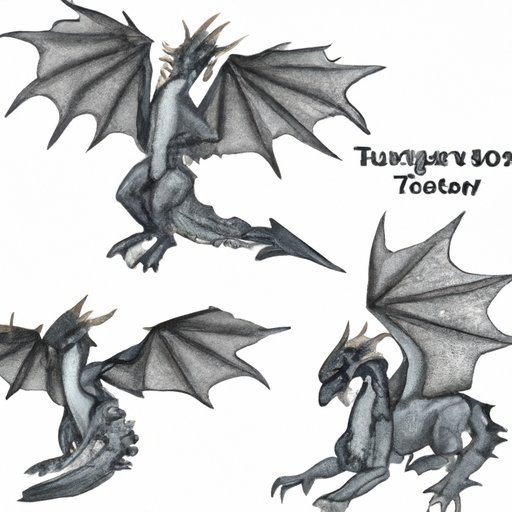Introduction
Dragons are a fascinating subject to draw, and learning how to draw them can be both a fun and rewarding experience. Whether you are a beginner or an experienced artist, there are many techniques and strategies that you can use to create your own amazing dragon artworks.
In this article, we will explore the basics of dragon anatomy and offer a step-by-step guide to drawing dragons. We will also cover more advanced techniques for shading, texture, and composition, as well as tips for creating your own unique dragon designs. So, let’s get started!
7 Simple Steps to Drawing a Dragon
For those who are new to drawing, here are 7 simple steps to follow to draw a basic dragon:
- Start with the basic shape of the dragon’s body.
- Add the legs and tail.
- Add the dragon’s head and neck.
- Draw the wings using a series of curved lines.
- Add details such as the eyes, mouth, and claws.
- Shade the dragon to give it depth and dimension.
- Add color (optional).
Remember to experiment with different shapes and styles to create your own unique dragon designs.
The Art of Drawing Dragons: A Beginner’s Guide
When it comes to drawing dragons, one of the most important things to keep in mind is their anatomy. Dragons have a unique body shape that can be challenging to draw, but with practice, anyone can master this art form.
Before you start drawing, it’s important to have the right materials. You will need a pencil, eraser, and paper. You may also want to have some colored pencils or markers on hand if you plan to add color to your artwork.
When it comes to drawing the dragon’s body, start with an oval shape for the torso and a smaller circle at the bottom for the hips. Connect the two shapes with two curved lines to form the dragon’s back.
From Scales to Wings: How to Draw a Dragon
Once you have the basic body shape for your dragon, it’s time to add some details. One of the most iconic features of a dragon is its scales. To draw scales realistically, start with a row of small circles along the dragon’s back. Then, connect the circles with curved lines to form the scales.
Another important element of a dragon is its wings. To draw the wings, start with a long, curving line that extends from the dragon’s back. Then, draw a series of smaller, curved lines that connect to the first line to create the shape of the wings. Remember to draw the wing bones to give the wings structure.
Unleash Your Inner Artist: Tips for Drawing Dragons
If you’re looking to take your dragon drawings to the next level, there are many techniques and strategies that you can use to make your artworks more dynamic and engaging.
One technique to try is using shading to give your dragon depth and dimension. Start by adding darker shades to the areas of the dragon that are furthest away from the light source, and gradually lighten the shading as you move towards the light. This will give your dragon a more 3-dimensional appearance.
You can also experiment with adding texture to your dragon using crosshatching or stippling techniques. This can be particularly effective when drawing elements such as scales.
Drawing Dragons for Kids: A Fun and Easy Tutorial
If you’re a younger reader who is interested in drawing dragons, there are many resources available to help you get started. One fun tutorial to try is the “easy dragon drawing” tutorial, which provides step-by-step instructions for drawing a simplified dragon with basic shapes and lines.
Remember, the most important thing is to have fun with your dragon drawings and let your imagination run wild.
Creating Your Own Dragon: A Step-by-Step Guide
If you’re feeling more adventurous, why not try creating your own unique dragon design from scratch? Start by choosing a theme for your dragon, such as fire or ice. Then, sketch out some ideas for the dragon’s body shape and features.
Once you have a basic design, start adding details such as scales, wings, and claws. You may also want to experiment with different colors and shading techniques to bring your dragon to life.
Mastering the Art of Dragon Drawing: Techniques and Strategies
By now, you should have a good understanding of the basics of drawing dragons. However, there is always room to improve and refine your skills.
Some additional techniques to try include experimenting with different poses and compositions, using reference images to help with shading and texture, and incorporating more advanced materials such as charcoal or ink.
Conclusion
Learning how to draw a dragon is a fun and rewarding experience, and with practice, anyone can become a master of this art form. Remember to have fun with your drawings and experiment with different styles and techniques.
